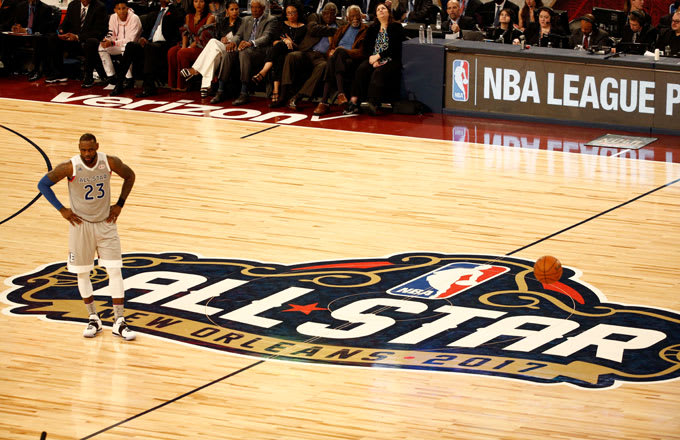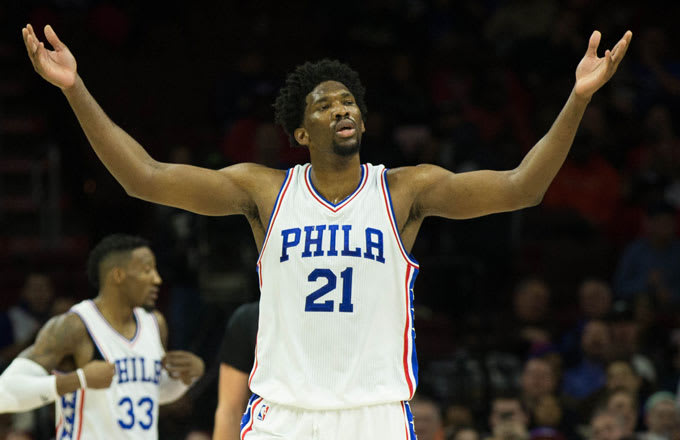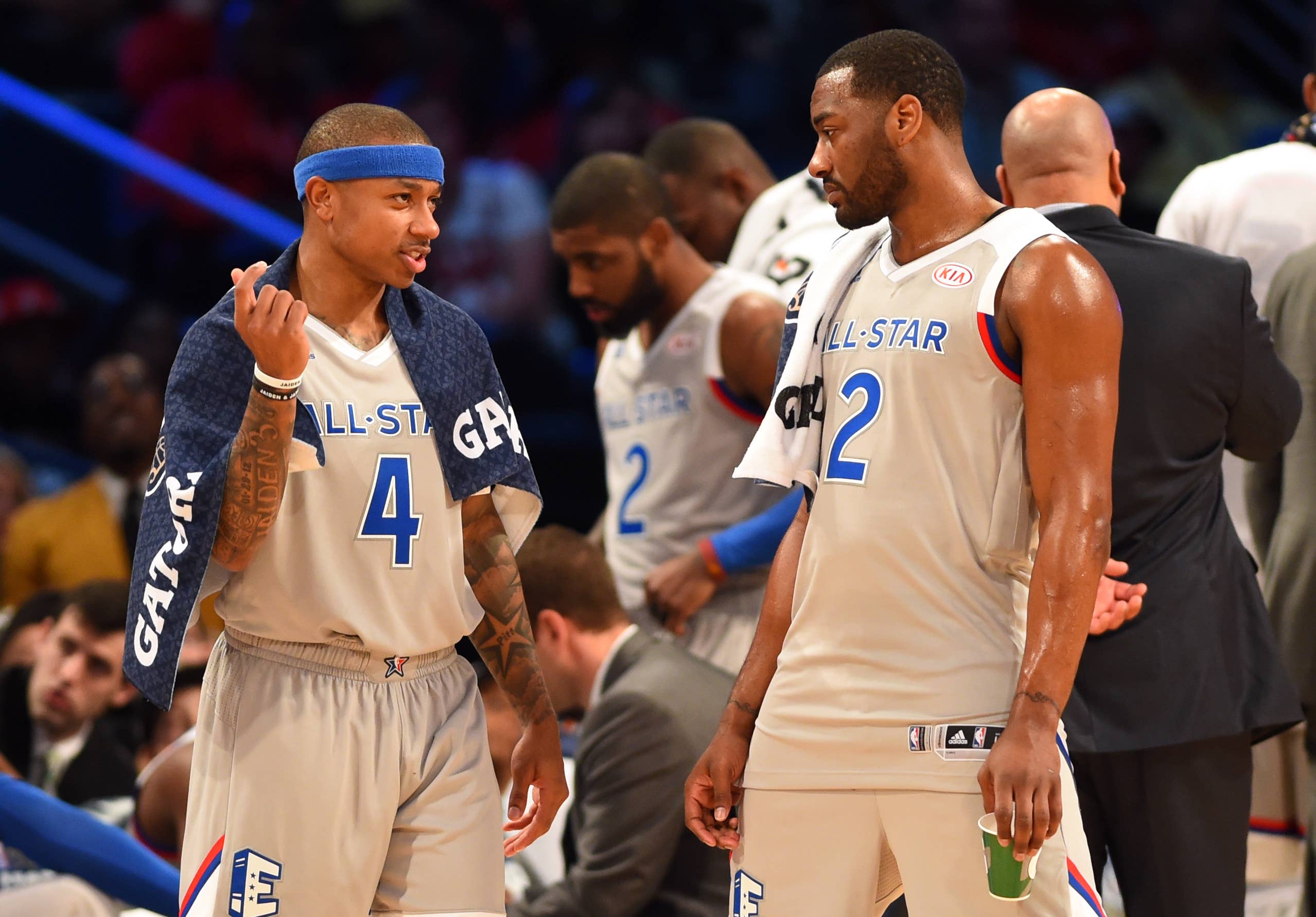
This summer, four members of the 2016-17 NBA All-Star team left the Eastern Conference to join teams in the West. And with Jimmy Butler, Paul George, Carmelo Anthony, and Paul Millsap gone and only Gordon Hayward to show for it, the East could be set for its worst season in a long time…given the league’s recent history that's saying a lot.
Last year marked the 17th time in 18 seasons that Western Conference teams finished with a better cumulative record than their Eastern Conference counterparts. And even in that lone season that bucked the trend in 2008-09, injuries to Tracy McGrady, Manu Ginobili, and Amar’e Stoudemire slowed down three of the best teams in the West and allowed the East to eek out a mere 12-game regular season advantage. In the NBA Finals that year, the Los Angeles Lakers made easy work of the Orlando Magic, besting them in five games to give the Western Conference what at the time was its eighth championship victory in 11 seasons.
Recent years have been equally unkind to the Eastern Conference. Over the past five seasons, the 50-win threshold has been surpassed 40 times total, but only 11 of those instances were by teams in the East. And it’s not just the frequency at which teams in the West achieve that arbitrary 50-win total that stands out; how consistently weak the teams atop the East are is equally alarming. Over that same stretch, the top four seeds in the East averaged 52.5 wins per season, versus 59 for top-four seeds in the West. It’s no wonder why LeBron James-led teams have reached the Finals in each of the past seven seasons but have only won it three of those times.
There might not be a lot of urgency to make these kinds of sweeping changes right now, but we’re one LeBron James free agent decision away from true disaster.
This isn’t groundbreaking stuff. The plight of the Eastern Conference has been widely documented (and incessantly memed) by analysts and fans alike for years. But in this piece I hope to figure out why this enduring inequity exists in a league with clear rules designed to promote parity and what can possibly be done to combat it. Let’s start with an examination of the structural differences that exist between the two conferences.
More than any league in pro sports, the NBA requires that teams acquire superstar talent as a prerequisite for competing at the highest level. One way to do that is through the draft, which allows the league’s worst franchises to lock up talented young players on long-term, team-friendly deals. Here, the only factors that really matter are the willingness of NBA owners and GMs to tank, the luck of the draw in the draft lottery, and, of course, good scouting. But when it comes to free agency and trades, players have more autonomy in dictating where they end up, and this is where things fall apart.
In both the East and the West, there are teams in cities with certain geographical, economic, and cultural advantages that make them more likely to attract talent. I might even go as far as to say that the East has a slight advantage in that regard, with Manhattan, Brooklyn, Chicago, Miami, Atlanta, Boston, Toronto, and Philadelphia probably making up a more appealing top half than Los Angeles (x2), Houston, Dallas, Oakland, Phoenix, New Orleans, and San Antonio.
But while players should be lining up to play in New York City and Chicago, those teams’ long-term struggles and inept management have largely taken them out of the running with most of the league’s top free agents. And in the West, teams like San Antonio, Memphis, and Oklahoma City have broken the mold and been consistently competitive in small markets thanks to front office acumen and appealing culture. In the East, teams like Charlotte, Indiana, and Milwaukee are not only disadvantaged due to their physical locations, they also lack the intangibles necessary to overcome those deficits.
But in a league where success is cyclical, shouldn’t things simply even out over time? The problem is that inertia is a powerful force both for the league’s contenders and its bottom-feeders, and momentum has been pulling the East and West apart for years.

In the ‘80s and ‘90s, the Bucks, Celtics, Sixers, Hawks, Pistons, Knicks, and Bulls all enjoyed stretches of four, five, six, seven, and even eight straight seasons with 50-plus wins thanks to superstars like Sidney Moncrief, Larry Bird, Julius Erving, Dominique Wilkins, Isiah Thomas, Patrick Ewing, and Michael Jordan. But once those players left or retired, those teams mostly sputtered out. The best way to build momentum is to acquire a franchise-altering star, and the quickest way to end it is to lose them.
In the West, the additions of players like Dirk Nowitzki, Tim Duncan, and Kobe Bryant in the late ‘90s ensured decades of enduring success within the Western Conference. Each of those players spent the entirety of their careers with one team, bringing at least one championship and a generation of competitive basketball to their respective franchise. Now Steph Curry fills that role for the Golden State Warriors and players like Russell Westbrook, Anthony Davis, and Karl-Anthony Towns hope to one day do the same for their teams. In the East, LeBron James and Dwyane Wade are the only players who come close to fitting the Dirk/Timmy/Kobe criteria, and even then they’ve merely remained in the same conference while still changing teams. The simple fact of the matter is that the East has a dynasty problem.
Since 2000, only three teams from the East have had more than three consecutive seasons with 50-plus wins (or the equivalent 41 in the lockout-shortened 2011-12 season). Those teams are the 2001-08 Detroit Pistons, the 2007-11 Orlando Magic, and the 2007-11 Boston Celtics. During that same stretch in the West, only the Rockets, Timberwolves, Pelicans, Blazers, and Jazz failed to win 50 or more games in four or more consecutive seasons.
Over this time frame, Dirk’s Mavs have had just one losing season, Timmy’s Spurs still haven’t finished with fewer than 50 wins in a season, and Kobe’s Lakers…well, the future’s bright for them at least. For the former two, solid management and an appealing culture should make them destination spots for years to come, and the Lakers’ logo and LA’s sunshine are enough to put them in most free agency conversations for the foreseeable future.
LeBron’s Cavs, on the other hand, are frankly cooked once he leaves. Their owner is garbage, their coach is meh, the management is inconsistent, and they’ve never once, in all the years they’ve had the greatest player on the planet, attempted to build something sustainable for the future. And Cleveland.

Up-and-comers like Philadelphia and Milwaukee could make things interesting, and the Celtics and Heat should continue to remain competitive because of their stable leadership and the cachet of their respective franchises. But with the Warriors, Rockets, and Spurs set to lead the West for the foreseeable future and teams like the Nuggets and Timberwolves on the come-up as well, it’s hard to see the East catching up any time soon.
So where do we go from here? Do we accept this as an unavoidable flaw in the league, or do we take steps to rectify the situation?
For years, a portion of NBA fans have spoken loudly about the benefits of abolishing conferences entirely and allowing the 16 best teams every season to make the playoffs. Recently, the idea was even floated by NBA Commissioner Adam Silver as a long-term possibility. It’s an intriguing concept, and with more than half the league currently earning a trip to the postseason it certainly doesn’t seem as if such a move would do much to keep out teams legitimately deserving of a playoff berth. In fact, last year’s 16 playoffs teams would have remained exactly the same under such a system, but the seeding would have rewarded teams like the Spurs, Rockets, Clippers, and Jazz, all of whom matched or exceeded the No. 2 seeded Cavaliers’ 51-31 record.
Silver noted that switching to a system like this would likely mean overhauling the NBA schedule such that every team played an identical or at least nearly identical slate of games. Currently, teams play intra-conference opponents three or four times each year and inter-conference opponents only twice. Making a change to this system would either require a lengthening of the NBA season in order to accommodate extra cross-country travel or a reduction in the number of games, two moves that are unlikely to be implemented in the short term.
But the reality of this proposal is that it would do nothing to fix the inequity between the two conferences, but would instead simply sweep the problem under the rug by keeping middling Eastern Conference teams out of the playoff hunt and creating a more difficult road for those teams that still do make it to postseason play. In fact, it would likely hurt the East’s ability to change its trajectory even more, making borderline playoff teams like Philadelphia and outside-shot contenders like Toronto less appealing to free agents and less likely to make a franchise-altering run in the postseason.
If the NBA is serious about bringing parity back to the league, it needs to think outside the box. An important question to ask might be, 'what incentive does the league have to make drastic change?'
The sad reality of the situation is that Silver doesn’t have the power to make Knicks owner James Dolan stop running his team like a drunken fantasy owner, nor does he have the ability to make free agents want to sign in Orlando. But one thing the league can do is make it easier for teams like the Knicks and Magic to rebuild around the kinds of young stars they need in order to turn their fortunes around. That means undoing recent anti-tanking draft reforms or eliminating the lottery altogether. It means getting rid of the max contract so that teams like the Washington Wizards can actually compete for free agents like Kevin Durant by overpaying a little bit if they’d like to. And it means setting a more restrictive team salary cap that doesn’t allow teams like the Golden State Warriors to sit $40 million over the soft limit set by the league.
There is no easy fix, and certainly the tank-happy model proposed above comes with its own set of problems. If the NBA is serious about bringing parity back to the league, it needs to think outside the box. An important question to ask might be what incentive the league has to make drastic change, given its ever-expanding purse and a rapidly growing international footprint? There might not be a lot of urgency to make these kinds of sweeping changes right now, but we’re one LeBron James free agent decision away from true disaster.

